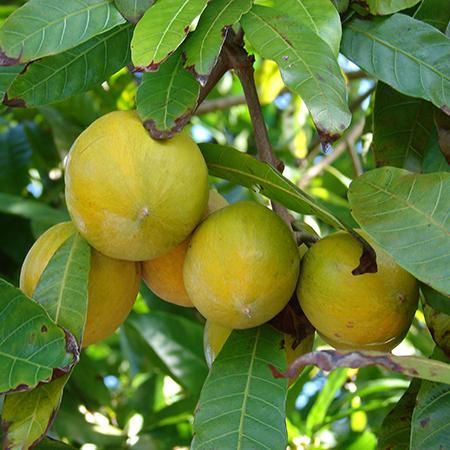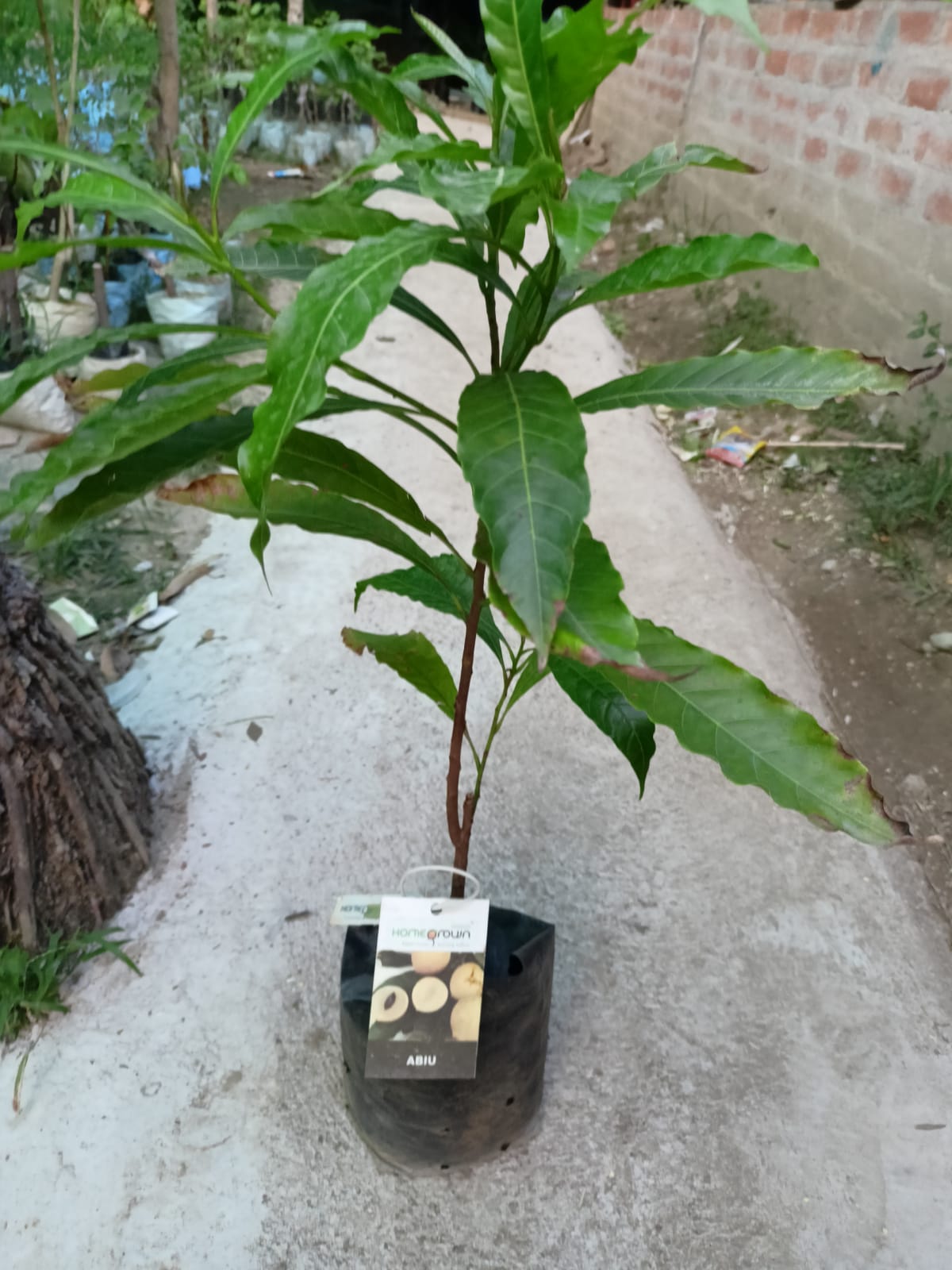Plantparadise
Abiu Fruit Plant | Buy Abiu Fruit Plant | Abiu Plant for Sale Online
Abiu Fruit Plant | Buy Abiu Fruit Plant | Abiu Plant for Sale Online
Couldn't load pickup availability
Buy Abiu Fruit Plant for Sale Online
Description: Abiu is a tropical fruit from South America that is found in Peru, Colombia, Venezuela, and Brazil. Its scientific name is Pouteria caimito. The fruit comes from the family Sapotaceae. In different parts of the world, people call the abiu fruit by different names
Relatives of Abiu: Mamey sapote, canistel, green sapote, sapodilla
Origin: Amazonian region of South America
Distribution: Abiu has been distributed throughout the tropics of Latin America and Southeast Asia.
History: Abiu was introduced into the US a number of times, e.g., 1914, 1915, and 1944. Abiu is an uncommon tree in south Florida due in part to its predisposition to injury from cool and cold temperatures.
Importance: Abiu is grown on a small commercial scale in Australia and Taiwan.
DESCRIPTION
TREE
Medium to large tree (30–40 ft [ 9.1–12.2 m]; up to 115 ft [35 m]) in tropical areas) with a pyramidal or oval canopy. The secondary and tertiary branches that emerge from the main limbs are generally willow-like (thin and long) and hang downward when heavy with fruit.
LEAVES
Alternate, oblong to elliptic, 4–8 inches (10–20 cm) long and 1 ¼–2 3/8 inches (3.2–6.0 cm) wide.
INFLORESCENCE (FLOWERS)
The flowers are borne singly or in a clusters of 2–5 flowers in leaf axils on long, thin shoots. Flowers are hermaphroditic, small, 4- to 5-lobed, cylindrical, and white to greenish. Flowers open during the morning and may stay open for about 2 days.
FRUIT
Ovoid to round, 1 ½–4 inches (3.8–10.2 cm) in diameter, 10 –25 oz (283–708 g), commonly with a short nipple at the apex. The peel is smooth, tough, and pale to bright yellow when ripe. The pulp is white, translucent, jelly-like, mild-flavored, and sweet in better selections and insipid in undesirable trees. There are 1–5 brown seeds. Immature fruit is permeated with unpleasant, gummy latex; fully ripe fruit have little to no latex. Fruit take 100–130 days from flowering.
POLLINATION
No specific information on the pollination requirements or pollinators (insects) of abiu has been documented. Flying insects are probably the pollinators.
VARIETIES
There are a number of abiu varieties (e.g., 'Gray', 'Z-2'); however, few selections or varieties are available in Florida. There is a lot of variability among seedling trees.
CLIMATE
Abiu grows best in hot, humid, tropical climates with well distributed rainfall. Trees may grow well in warm, humid, subtropical areas if protected from constant winds and freezing temperatures. Optimum growth temperatures are from 68–95°F (20–35°C). Abiu trees are sensitive to cool, non-freezing temperatures and windy conditions, and should be planted only in warm, wind-protected areas. Young trees may be killed at temperatures below 32°F (0°C) and mature trees at 29–31°F (-0.5– -1.6°C).
PROPAGATION
Abiu is commonly propagated by seed; seedling trees usually begin fruit production in 3–4 years after planting. Once extracted from the fruit, abiu seeds do not remain viable for more than a couple of days and should therefore be planted as soon possible into clean, well-drained media. Seedling trees come into production in 2–5 years from planting. Abiu may also be grafted or budded onto seedling rootstocks and begin fruiting in 1–2 years.
PRODUCTION (CROP YIELDS)
The amount of fruit produced varies greatly among abiu seedling trees. Some mature seedling trees may produce little fruit; others yield 400 lbs (182 kg) of fruit per year. Historically abiu season in Florida has been during the fall.
SPACING
Abiu trees should be planted at least 25 ft (7.6 m) from nearby trees and structures because mature trees not regularly pruned may become quite large.
SOILS
Abiu trees are best adapted to fertile, acid- to slightly-alkaline-pH (5.5–7.5), well-drained soils. Trees growing in high-pH, alkaline soils may develop iron deficiency.
PLANTING AN ABIU TREE IN THE HOME LANDSCAPE
Proper planting is one of the most important steps in successfully establishing and growing a strong, productive tree. The first step is to choose a healthy nursery tree. Commonly, nursery abiu trees are grown in 3-gallon (11-liter) containers and trees stand 2–4 ft (0.6–0.9 m) from the surface of the soil media. Large trees in smaller containers should be avoided as the root system may be "root bound." This means all the available space in the container has been filled with roots to the point that the tap root is growing along the edge of the container in a circular fashion. Root bound root systems may not grow properly once planted in the ground. Inspect the tree for insect pests and diseases, and inspect the trunk of the tree for wounds and constrictions. Select a healthy tree and water it regularly in preparation for planting in the ground.
SITE SELECTION
In general, abiu trees should be planted in full sun for best growth and fruit production. Select a part of the landscape away from other trees, buildings and structures, and power lines. Remember, abiu trees can become large if not pruned to contain their size. Select the warmest area of the landscape that does not flood (or remain wet) after typical summer rainfall.
PLANTING IN SANDY SOIL
Many areas in Florida have sandy soil. Remove a 3- to 10-ft-diameter (0.9–3.1 m) ring of grass sod. Dig a hole 3–4 times the diameter and 3 times as deep as the container the abiu tree came in. Making a large hole loosens the soil next to the new tree, making it easy for the roots to expand into the adjacent soil. It is not necessary to apply fertilizer, topsoil, or compost to the hole. In fact, placing topsoil or compost in the hole first and then planting on top of it is not desirable If you wish to add topsoil or compost to the native soil, mix it with the excavated soil in no more than a 1:1 ratio.
Backfill the hole with some of the excavated native soil. Remove the tree from the container and place it in the hole so that the top of the soil media from the container is level with or slightly above the surrounding soil level. Fill soil in around the tree roots and tamp slightly to remove air pockets. Immediately water the soil around the tree and tree roots. Staking the tree with a wooden or bamboo stake is optional. However, do not use wire or nylon rope to tie the tree to the stake because they may eventually damage the tree trunk as it grows. Use a cotton or natural fiber string that will degrade slowly.
PLANTING IN ROCKLAND SOIL
Many areas in Miami-Dade County have a very shallow soil, and several inches below the soil surface is hard, calcareous bedrock. Remove a 3- to 10-ft-diameter (0.9–3.1 m) ring of grass sod. Make a hole 3–4 times the diameter and 3 times as deep as the container the abiu tree came in. To dig a hole, use a pick and digging bar to break up the rock or contract with a company that has augering equipment or a backhoe. Plant the tree as described for sandy soils.
PLANTING ON A MOUND
Many areas in Florida are within 7 ft (2.1 m) or so of the water table and experience occasional flooding after heavy rains. To improve plant survival consider planting fruit trees on a 2- to 3-ft-high by 4- to 10-ft-diameter (0.6- to 0.9-m by 1.2- to 3.1-m) mound of native soil. After the mound is made, dig a hole 3 to 4 times the diameter and 3 times as deep as the container the tree came in. In areas where the bedrock nearly comes to the surface (rockland soil), follow the recommendations for the previous section. In areas with sandy soil follow the recommendations from the section on planting in sandy soil.
CARE OF ABIU TREES IN THE HOME LANDSCAPE
A calendar outlining the month-to-month cultural practices for abiu is shown in Table 1.
FERTILIZER
In Florida, young trees should be fertilized every 1–2 months during the first year, beginning with 1/4 lb (114 g) of fertilizer and increasing to 1 lb (455 g) per tree (Table 2). Thereafter, 3 or 4 applications per year in amounts proportionate to the increasing size of the tree are sufficient, but do not exceed 20 lbs per tree per year.
Fertilizer mixtures containing 6–10% nitrogen, 6–10% available phosphoric acid, 6–10% potash, and 4–6% magnesium give satisfactory results with young trees. For bearing trees, potash should be increased to 9–15% and available phosphoric acid reduced to 2–4%. Examples of commonly available fertilizer mixes include 6-6-6-2 [6 (N)-6 (P2O5)-6 (K2O)-2 (Mg)] and 8-3-9-2 [8 (N)-3 (P2O5)-6 (K2O)-3 (Mg)].
From spring through summer, trees should receive 3 to 4 annual nutritional sprays of copper, zinc, manganese, and boron for the first 4–5 years. Abiu trees are susceptible to iron deficiency under alkaline and high-pH soil conditions. Iron deficiency can be prevented or corrected by periodic soil applications of iron chelates formulated for alkaline and high-soil-pH conditions. Periodic applications of ferrous (iron) sulfate may be made to trees growing in low-pH soils.
IRRIGATION (WATERING)
Newly planted abiu trees should be watered at planting and every other day for the first month or so and then 1 to 2 times a week for the next couple of months. During prolonged dry periods (e.g., 5 or more days of little to no rainfall), newly planted and young abiu trees (first 3 years) should be well watered twice a week. Once the rainy season arrives, irrigation may be reduced or stopped.
Once abiu trees are 4 or more years old, irrigation will be beneficial to plant growth and crop yields during prolonged dry periods. The specific water requirements for mature trees have not been determined. However, as with other tree crops, the period from bloom and through fruit development is important, and drought stress should be avoided at this time with periodic watering.
ABIU TREES AND LAWN CARE
Abiu trees in the home landscape are susceptible to trunk injury caused by lawn mowers and weed eaters. Maintain a grass-free area 2–5 or more feet (0.6–1.5 m) away from the trunk of the tree. Never hit the tree trunk with lawn mowing equipment, and never use a weed eater near the tree trunk. Mechanical damage to the trunk of the tree will weaken the tree and, if severe enough, can cause dieback or kill the tree.
Roots of mature abiu trees spread beyond the drip-line of the tree canopy. Heavy fertilization of the lawn next to abiu trees is not recommended because it may reduce fruiting and or fruit quality. The use of lawn sprinkler systems on a timer may result in over watering and cause abiu trees to decline. This is because too much water too often applied causes root rot.
INSECT PESTS AND DISEASES
Few insect pests attack abiu, however, as the number of trees increases, various insects will most likely be found feeding on abiu. The Caribbean fruit fly (Anastrepha suspensa) attacks abiu allowed to over ripen (golden yellow color) on the tree. This may be prevented by picking fully mature fruit before they ripen on the tree or bag the developing fruit. Please contact your local county extension agent for current control recommendations.
HARVEST, RIPENING, AND STORAGE
As abiu fruit mature, the peel changes from green to light green and then yellow, indicating it is ready to pick. Abiu should only be picked when fully mature, i.e., partial color break to full yellow color; however, fruit with a dark golden color are overripe. Fruit picked before fully mature contain a large amount of sticky, white latex, making consumption unpleasant. Mature fruit should be placed at room temperature to ripen fully (full yellow color development); usually in 1–5 days. Once fully ripe, fruit may be stored in the refrigerator for several days prior to consumption.
USES AND NUTRITIONAL VALUE
Abiu is usually eaten as a fresh fruit but may be an ingredient of sorbets and ice-cream. Abiu fruit contain vitamin A, ascorbic acid, phosphorous, and calcium
Materials
Materials
Shipping & Returns
Shipping & Returns
Dimensions
Dimensions
Care Instructions
Care Instructions






